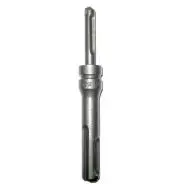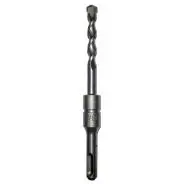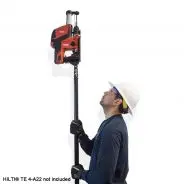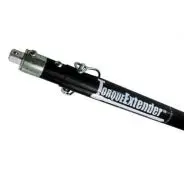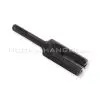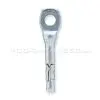
Overhead Drilling and Anchoring
Overhead work demands more from your body, your tools, and your time. Whether you’re securing drop rods in concrete ceilings or setting anchors for cable trays, overhead drilling and anchoring is one of the most physically challenging parts of any install.
At Hook and Hanger, we understand the strain this kind of work can place on tradespeople. That’s why we supply tools and fasteners specifically designed to make overhead jobs safer, faster, and more efficient, so you can get the job done right without overworking yourself in the process.
Why Overhead Drilling and Anchoring Demands Special Attention
Working above your head changes the rules. You’re not only contending with awkward angles and limited visibility, but also the physical toll that sustained overhead motion places on the neck, shoulders, and arms. Even for experienced installers, fatigue can build up fast.
Then there's the ceiling material itself, concrete, block, or steel, all of which respond differently to hammer drilling and anchoring. Dust blowout, cracked holes, or improper embedment depth are all common risks if you don’t have the right tools in hand.
Overhead drilling also increases the likelihood of dropped tools, debris exposure, and alignment errors. When you factor in access platforms or ladders, the complexity only grows. These aren’t just inconveniences, they’re safety risks.
That’s why Hook and Hanger focus on practical, job-specific solutions that help reduce the effort required while maintaining a high standard of work. Our aim is to support professionals who face these challenges daily by offering tools built with real-world needs in mind.
Choosing the Right Tools for Overhead Drilling and Anchoring
Standard drills and anchors may work on walls or floors, but overhead applications need more thought. For lighter-duty tasks, a cordless hammer drill with SDS-plus or SDS-max bits may do the job, but if you're drilling into concrete ceilings all day, the process quickly becomes exhausting.
To reduce fatigue and improve safety, many contractors now use dedicated tools like the Overhead Drill Machine (ODM), such as our ODM Generation 2 system. Designed to operate entirely from ground level, it eliminates the constant need to reposition ladders or lifts.
Equipped with extension poles like our telescopic drill attachments, the ODM lets users adapt to different ceiling heights. It features a universal saddle compatible with most hammer drills and can be fitted with a detachable foot pedal, allowing activation without lifting your arms above your head. This setup helps reduce repetitive strain and speeds up work exponentially.
We also supply Halt Bits like the ODM-250 (¼" x 1.25") and ODM-375 (3/8" x 3.75"), specially sized for overhead concrete drilling. These are designed to deliver smooth, reliable performance with reduced vibration, ideal for precision anchor holes.
Once the holes are drilled, anchoring is just as important. Tools like the I-Wedge make it easier to install wedge anchors consistently, while Components like eye lag screws and the I-Pin Tie Wire Anchors simplify installations for suspended ceilings and wire-hung supports. For more control in confined or high-torque situations, the TorqueExtender (TE-12) adds reach and leverage without compromising alignment.
These tools are more than just gear; they’re part of a complete system tailored for overhead ceiling installs, helping you work safer and more efficiently from the ground up.
Practical Challenges in Overhead Installations
Even with the right gear, overhead drilling and anchoring come with their learning curve. Drilling blowout, where the rear of the hole collapses or fails to hold the anchor, is common in brittle substrates or older concrete. Using properly sized bits and depth-setting tools helps maintain consistency.
Misalignment is another issue. Working above eye level makes it harder to drill straight or place anchors flush with the surface. Over time, this leads to poor load distribution or failure points in the ceiling. That’s why many contractors turn to alignment aids or pre-marked layouts to improve accuracy across large-scale installs.
Then there's the issue of vibration and control. Overhead hammer drilling without stability can quickly wear out your gear and your arms. Low-vibration tools and smart accessories like the ODM’s foot control system make a major difference over the course of a long day.
Finally, dust management can’t be overlooked. Without extraction or collection, drilling above your head sends fine particles directly into your face, eyes, and lungs. Some operators use vacuum-equipped drills, but when working at scale, especially with systems using purlin clips, containment often relies on built-in dust cups or site controls.
At Hook and Hanger, these real-world issues are what drive the development of our specialized hardware. Our goal is to help tradespeople install with confidence, even when working above their heads all day long.
Trade-Specific Use Cases: Electrical, Mechanical, and Ceiling Grid Systems
Overhead drilling and anchoring are common across electrical, mechanical, and ceiling fit-out work. But each trade faces slightly different challenges and hardware requirements.
Electricians often install drop rods, cable management systems, or cable trays suspended from concrete ceilings. These applications rely on tie wire anchors, precision-drilled holes, and consistent embedment depth. Any misalignment can lead to long-term sag or safety issues.
Mechanical contractors, on the other hand, may be anchoring heavier systems like ducting or pipework. Here, higher-load anchors are required, usually wedge anchors or threaded rod fasteners like epoxy-set rods. The job demands both reliable hold and vibration resistance, especially when equipment is operating overhead.
Ceiling installers typically work with suspended ceiling systems such as suspended T-bar grids. Fast, repeatable installs are key, especially in large commercial settings. Using an ODM with drill extension poles means the installer can move quickly from point to point without needing to climb up and down, saving hours throughout a job.
In all cases, Hook and Hanger provide tools that make these roles safer and more manageable. Whether you’re setting anchors above a data center or suspending ducting in a warehouse, having the right drilling system at hand makes all the difference.
For added versatility, installers often rely on lightweight fixings such as angle clips to secure fittings in tight or angled ceiling areas.
What to Consider Before Your Next Overhead Job
Overhead drilling and anchoring shouldn’t be underestimated. It’s one of the most physically demanding and technically sensitive aspects of install work, and the margin for error is small.
Before you get started:
Understand the ceiling material you’re working with
Choose anchors that match your load and embedment needs
Use tools that reduce vibration and strain on your body
Plan for dust control and safety, especially when working from the ground
With the right equipment and preparation, you can reduce risk, speed up the job, and ensure lasting, professional results.
Need Hardware or Support for Overhead Drilling and Anchoring?
Hook and Hanger supplies a full range of tools and fasteners designed specifically for overhead applications, from ODMs and drill bits to tie wire anchors and torque extenders.
If you need help selecting the right gear for your ceiling install, we’re here to assist. Just reach out to our team, we’re happy to answer your questions or recommend products based on your job requirements.

